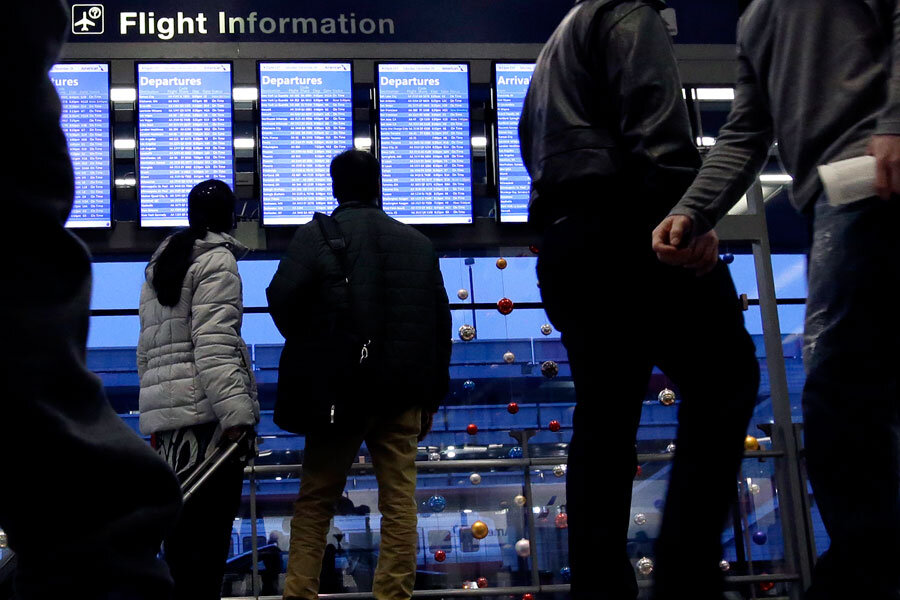O'Hare adds runway. Solution to both airport delays and mayor's troubles?
Loading...
Chicago’s O’Hare Airport will get a sixth runway, Mayor Rahm Emanuel announced Sunday.
The $1.3 billion project will include a sixth east-west runway, more de-icing pads to get planes in the air faster and new taxiways so planes can commute to and from gates more easily. And Mayor Emanuel says the city plans to build two new airport hotels and upgrade the airport’s present Hilton hotel.
The mayor hopes the project will reduce O’Hare’s record flight delays. RealClearWorld ranks Chicago O’Hare as the sixth most-delayed airport in the world with an on-time departure rate of 62.68 percent.
“The new runway will complete a modernization project that began more than a decade ago, changing O’Hare’s configuration form several intersecting runways to a configuration of six parallel, east-to-west runways and two diagonal runways,” NPR explains.
Despite the decade-long modernization project, travel industry experts say O’Hare’s chronic delays continue because the project hasn’t increased terminal space or added new gates.
“The shortage of gates is a serious issue that has to be addressed,” travel industry analyst Henry Harteveldt of Atmosphere Research Group told the Chicago Tribune. Not only does the shortage of gates and terminals cause delays, but it also limits lower-cost airlines like Spirit or Virgin America from adding flights and bringing more passengers through Chicago.
And outside of efficiency goals, Emanuel also hopes O’Hare’s future economic growth can be a positive beacon in his otherwise tumultuous mayorship.
To further alleviate Chicago’s current racial grievances, Emanuel announced plans to spread the wealth from the $1.3 billion project among the city’s minorities and underserved communities.
“We’re going to do something different with this investment,” the mayor said in a statement. “We’re going to do it in a way where O’Hare is not longer an island… but make sure that everybody from every part of the city of Chicago participates in the growth of O’Hare and the opportunity to get a job and a career in that effort.”
In order assist Chicago residents, Emanuel announced contracting rules that will favor the city’s minorities when doling out the project’s estimated 5,000 jobs – an announcement that’s carried weight among community leaders.
“We are thrilled about this important opportunity to bring additional economic development to Chicago’s neighborhoods,” Shari Runner, president and CEO of the Chicago Urban League, said in a city press release. “It is more important than ever before to ensure that the jobs created from modernizing O’Hare Airport lift up our underserved communities.”
Ms. Runner tells NPR that it’s important to make sure it will not only be a diverse workforce, but that it will also be a diverse contracting opportunity. But she says she is not aware of specific diversity goals for the O’Hare runway project.
“We have a long way to go,” Runner added. “We don’t want this to be the exception. We want this to become the rule.”
Of course, the O’Hare expansion isn’t all smooth sailing and good press for the mayor.
Homeowners neighboring O’Hare have long criticized the increased jet noise that’s coincided with more east-west takeoffs and landings.
“Today’s announcement by CDA and Mayor Emanuel includes some much needed improvements to O’Hare airport, but ignores the noise challenges our constituents in the neighborhoods adjacent to O’Hare have been experiencing,” US Representatives Mike Quigley (D), Tammy Duckworth (D) and Jan Schakowsky (D) said in a joint statement Monday. “We believe that prioritizing the construction of yet another east-west runway without first addressing the significant increases in noise that our constituents have endured … comes at the expense of our constituents’ health and property values.”
Not only does the new runway run east-west itself, but the plan also includes closing an existing diagonal runway that anti-noise advocates wanted O’Hare to utilize to minimize noise disruption.
O’Hare and Atlanta’s Hartsfield-Jackson airport have been longtime rivals for the title of busiest US airport.
But “the measure going forward from now on, is not whether we are the busiest but whether we are the best,” Emanuel said Sunday. Instead of explicitly announcing the project as a means to greater-traffic-ends, Emanuel named the project "O’Hare 21’" to signal the airport’s status as an “economic engine, job-growth engine for the 21st century.”
Once the sixth runway is complete, the annual capacity for O’Hare takeoffs and landings will increase 25 percent: from 214 per hour to 267 per hour. Construction is set to begin and May and the project is expected to be complete in 2020.
The $1.3 billion project is funded from a number of sources, including the US Department of Transportation, the Federal Aviation Administration, passenger fees, American and United Airlines.






